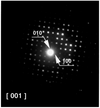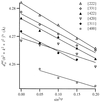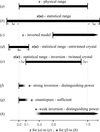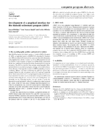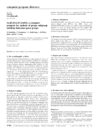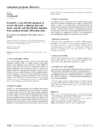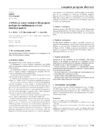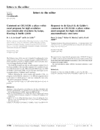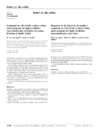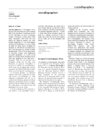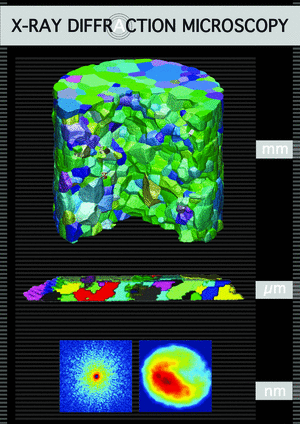issue contents
August 2000 issue

Cover illustration: Reorientation pathways of the octahedral PF6 anion in KPF6, calculated by an evolution algorithm. Courtesy of K. Knorr (University Kiel, Earth Sciences - Mineralogy) and Fritz Mädler (HMI Berlin) [J. Appl. Cryst. (1999), 32, 902-910].
research papers
Hydrogen absorption–desorption cycling in LaNi5 and substitutional derivatives induces anisotropic diffraction peak broadening. The change of the anisotropy as a function of substitution (by Co, Mn, Al, Fe, Cu, Sn and Ce) is discussed in terms of various dislocation substructures.
Two approaches to the correction of grazing-incidence X-ray diffraction data are described: one taking into account the evolution of the diffracting area during an ω scan; the other considering the case of finite-width rods, under the point-like sample approximation. A full numerical simulation is also presented.
High-resolution X-ray diffraction measurements were carried out on ZnO/Si devices under surface acoustic wave excitation and revealed some very clear satellite diffraction peaks that are obtained from the sinusoidal modulation of the near-surface region. This experiment shows that the propagation of a Rayleigh surface acoustic wave in a perfect crystal acts as a dynamical diffraction grating.
Section topographs recorded at different spatial locations and at different rocking angles of a highly oriented pyrolytic graphite crystal allow three-dimensional maps of the local angular-dependent scattering power to be obtained. The maps allow the extraction of information on local structural parameters such as size, form and internal mosaic spread of crystalline domains, and represent a new approach to the characterization of mosaic crystals.
On-line X-ray studies of structural development during continuous polypropylene fiber drawing were carried out using synchrotron radiation. A unique image analysis method was introduced to extract quantitative information on the crystal, amorphous and mesomorphic fractions.
Electron diffraction analysis, nuclear magnetic resonance measurements, structural determination and refinements were performed on two ferroelectric lead-containing ceramics (classical and relaxor), with tetragonal tungsten bronze structure, in order to investigate the origin of the relaxor behaviour in such compounds.
A description of a diffuse X-ray scattering measurement technique using high-energy X-rays in Weissenberg flat-cone geometry is presented.
Ultrasonic standing waves, excited in FeBO3 (111) crystal plates through magneto-elastic coupling, have been visualized using monochromatic Bragg diffraction imaging (topography) employing synchrotron radiation. The images depend strongly on whether diffraction by the sample occurs in the same plane as in the double-crystal monochromator, or in the perpendicular plane.
New methods of diffraction stress analysis of polycrystalline materials, consisting of cubic elastically anisotropic crystallites, are proposed and compared with existing methods. The new methods do not require diffraction elastic constants.
A procedure for computing the resolution function for a crystal neutron diffractometer, taking into account the spatial configuration of the experimental setup and the monochromator curvature, is presented.
The treatment of KGa-1 kaolinite with dimethyl sulfoxide and ammonium fluoride heated at 383 K provides an unstable hydrated phase characterized by a 10 Å basal distance; when air-dried, this hydrate gives a dehydrated phase at 7.15 Å. This hydrate has been structurally characterized via a comparison between experimental and calculated X-ray diffraction profiles.
X-ray refraction by a prism has been used to discriminate between different harmonic orders of a two-crystal monochromator. Rejection of higher-order harmonics and selection of specific harmonic order is demonstrated.
A least-squares procedure is used to determine the orientation of a crystal in a tilted diffraction geometry from a single electron diffraction pattern. The scheme can be universally applied to crystals with one, only a few, or many crystallographic layers and yields highly accurate Eulerian angles of the diffraction geometry.
Applying least-squares and correlation methods it is possible to separate the shape of the reciprocal lattice from the molecular transform using a single electron diffraction pattern. This separation is one crucial step in the structure determination of beam-sensitive multilayered three-dimensional microcrystals.
The composition and hydration of E. coli ribosomes isolated with different purification protocols has been analysed by combining two experimental techniques: measurements of small-angle neutron scattering, for two different isotopic solvent compositions, and refractive index increments.
Using convergent-beam electron diffraction (CBED), the fine structure factors of Co3Ti alloys have been measured and the effects of boron microalloying on the fine structure factors have been studied. The extinction distances of Co3Ti have been obtained by both Kelly's method and the CBED simulation method.
A method is proposed to calculate diffraction line profiles from specimens with dislocations. Calculated results are compared to results obtained from analytical models.
Smoothing distortions of an X-ray diffraction peak are theoretically analysed and formulae to calculate the smoothing-induced changes of all parameters of a peak are derived.
Based on the analysis of geometric relations, it is found that the amplitude of the distortion of the full width at half-maximum (FWHM) of a peak after smoothing is the largest among the distortions of the seven parameters of a peak: maximum intensity, FWHM, shape, asymmetry, integral intensity, peak position and integral width. It is found that the smoothing-induced distortions of an actual X-ray diffraction peak trend towards those of ideal curves.
Free 

Detailed practical and numerical information is provided for undertaking and evaluating absolute-structure and absolute-configuration determinations.
The distribution of inverted ferroelectric domains on the surface and within the bulk of a periodically poled KTA single crystal has been observed using a simple synchrotron X-ray diffraction imaging setup. This technique allows one to reveal the phase difference between the waves that are Bragg diffracted from adjacent domains via free-space propagation (Fresnel diffraction).
Calculations in macromolecular crystallography inherently have a high degree of parallelism. The OpenMP programming interface can be used in crystallographic programs to reduce computation times on multiprocessor computers.
The instrumental transparency functions of five commercially available texture goniometers were measured with highly perfect, monocrystalline silicon samples. The transparency function is the fundamental characteristic of a texture goniometer, defining its angular resolving power.
short communications
Download citation


Download citation


A detailed study of the cubic to rhombohedral high-pressure transition of NbO2F has been performed by powder diffraction using synchrotron X-ray radiation and diamond anvil cells, showing that the transition starts at 0.28 and is complete at 0.65 GPa.
computer programs
LAPODS is an upgraded version of the program LAPOD for the refinement of lattice parameters. It has several new features, including automatic determination of significant systematic errors, based on statistical considerations.
New techniques are described for indexing a powder pattern. The program, an evolution of TREOR90, has been integrated into the package EXPO.
computer program abstracts
BEAM-ish is a graphical user interface that manages the processing of multiple super-fine φ-sliced diffraction images and seamlessly integrates several programs for mosaicity calculations.
The program DBWS Tools is an application for DBWS users that compiles input control files for versions 9411 and 9807 and manages program execution using a Windows 95/98/NT interface.
The main aim of SUBGROUPGRAPH is a detailed study of a group–subgroup relation between two space groups, G > H, including the construction of chains of maximal subgroups for G > H for a specified/non-specified index i = |G:H| (the so-called G–H graph), the determination of the number of the different Hk < G, Hk ≅ H, and their distribution into classes of conjugate subgroups relative to G, etc.
This program allows S(Q) and the pair-distribution function to be determined from a variety of time-of-flight neutron powder diffractometers. Features are a graphical user interface and permanent storage of processing parameters.
The program package TOPOS is intended for the automation of all stages of crystal-chemical analysis.
letters to the editor
Free 

Comment on Langs, Blessing & Smith [J. Appl. Cryst. (2000), 33, 174–175].
Free 

Response to comment on Langs, Blessing & Smith [J. Appl. Cryst. (2000), 33, 174–175].
crystallographers
Free 

Free 



 journal menu
journal menu













